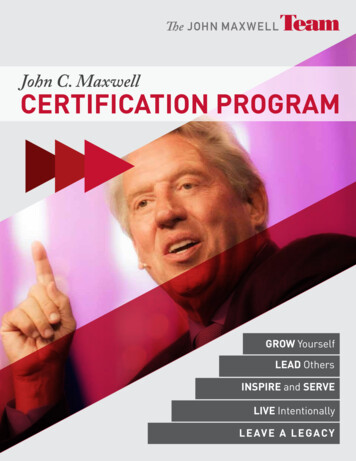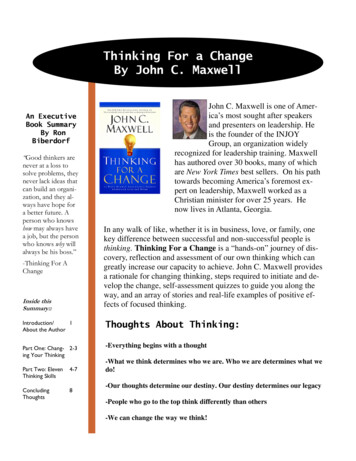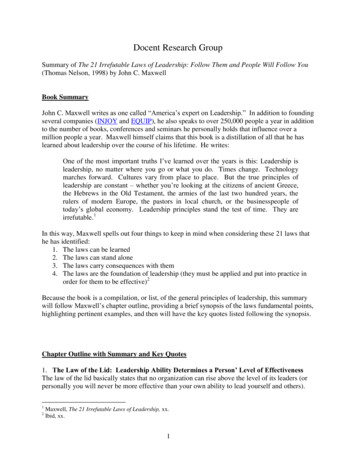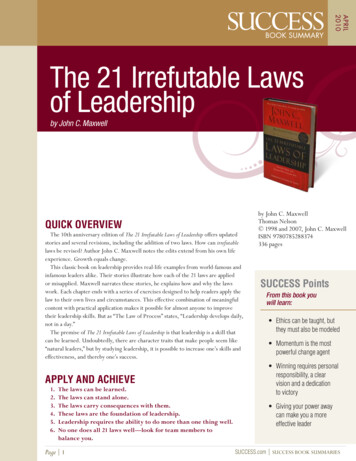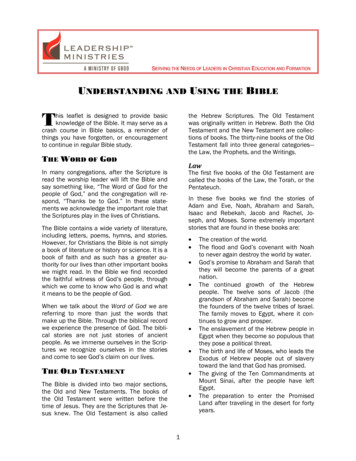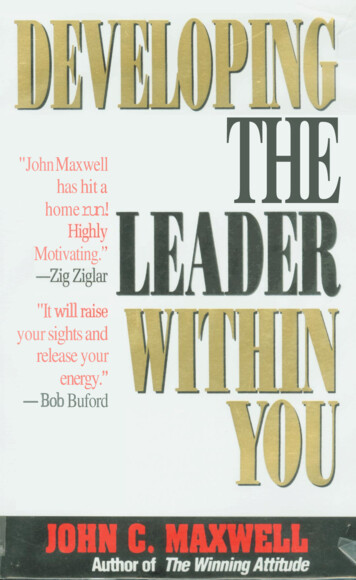
Transcription
"John Maxwellhas hit ahomerun!Motivating.'7:-"'7:-1--"It will rais your sights andrelease yourenergy."-Bob BufordTHE
"JohnMaxwell has hit a home run! Developing the Leader Within You ishighly motivating. 'Must'reading for corporate and aspiring executives."-228 ziglarChman,The Zig Ziglsr Ccoporation"In this book, John Maxwell combines the street smarts of a hands-onperfinmer,who loves to practice the art of leadership with a lively,easy-to-get-it style. Read this book! It will raise your sights andrelease your energy."-Bob BufordChman,Peter E Drucker Foundation for Nonpmfit Management"One of the best books on leadership ever to be written by a man who practiceswhat he preaches. It's abookI urge every would-be leader to read."-Robert H.Schder"Eminently practical advice! . . . will h,guide, direct and influence thosecalled to leadership. There is wonderful, meaningful help herefor everyone at every rung of the leadership ladder."-Ted EngsfmmPrasident Emeritus, World Vision"Simply put, [Developingthe Leader 115thin Ywl may very well be the bestbook you will ever see on the subject of leadership."-Jack w wallCh\airman. residentand Chief Exmtive OEim,Fccdmaker,Inc.ISBN 983-897-025-5
LEADERwmYOUJOIN C. MAXWELLIf you are in any sort of leadership position, bornbusiness executive or church leader to parent or teacher,you have pmbabl asked yourself many times whatit takes to make a eader. And now you can find theanswer in Developingdie Leader Wthin You.!By examining the differences between leadershipstyles, John Maxwell outlines principles for ins iring,, and influencing others. These princip/'es canin any organization to foster integrity and selfbediscipline and bring about a positive change.m0tiv3Developingdie Leoder Wthin You also examineshow to be effective in the highest calling of leadershipby understanding the five characteristicsthat set "leadermanagers" apart fmm "m-of-themill managers."Let John Maxwell show you how to developthe vision, value, influence, and motivationrequired of successful leaders.
FROM INJOY1-800-333-6506Founded in 1985 by John C. Maxwell,INJOY ir a leadership developmentinstitute tommined to intreoring theeffeciiveness of people in all area of lifeThrough INJOY, John Maxwell offers awide range of training seminars, books,videos, and rmsette programs designedto intreme an individual's ability toinfluence and lead others.A unique rerource is the INJOY Life Club,o one-hour teathing tape by JohnMaxwell, mailed monthly to thousands osubstribers. October 1993 marks the100th edition of this monthly tape seriesTo receive a rotalogue of rerourtesavailable from INJOY and additionalinformation regarding John Maxwell'srpeaking itinerary, please tall toll-free 1800-333-6506 or write INJOY, 1530Jamatha Rood, Suite 0, El Cajon, (A,92019.Photograph by Victor AvilaJohn Maxwell has been senior pastorof Skyline Wesleyan Church inLemon Grove (San Diego),Californiasince 1981. Generally considered themost influential leader of hisdenomination, he speaks extensivelyacross the United States on the issuesof leadership, relationships, andchurch g o d . He also reaches largenumbers of church and busiiessleaders through his popularaudiotapes, videos, and books, allproduced by Injoy, a leadershipdevelopment institute,founded byJohn Maxwell.Maxwell's previous books include BeAII You Can Be, Be a People Person,Think on These Things, ToughQuestions Honed Answers, andThe Winning Attitude, which is onHarvard's must-read list.-Jacket Des gnThe Burgundy Groupi
.-0F
DEVELOPING THE LEADER WITHIN YOUCopyright 0 1993 by Injoy Inc.All rights reserved. Written permission must be secured from thepublisher to use or reproduce any part of this book, except for briefquotations in critical review or articles.First published in Nashville, Tennessee, USA by Thomas Nelson, Inc.,1999 Castle Edition for AsiaThis edition is published by special arrangement with and permissionof Thomas Nelson Inc., Nashville, Tennessee, USACastle Book is an imprint ofGlad Sounds Sdn Bhd (25817-A)4 Jalan Utara46200 Petaling JayaSelangor Darul Ehsan, MalaysiaTel : (6) 03-7556442 / 7562901 / 7563753Fax : (6) 03-7560528Printed in Malaysia by Percetakan Osacar Sdn Bhd (63461-W)ISBN 983-897-025-51 2 3 4 5 6 7 8-02 01 00 99This book is dedicated to the man I most admire.A friend whose touch warmed me;A mentor whose wisdom guided me;An encourager whose words lified me;A leader I love to follow . . .My fatherMelvin Maxwell
CONTENTSIntroduction1. The Definition of Leadership:ix1INFLUENCE2. The Key to Leadership:19PRIORITIES3. The Most Important Ingredient of Leadership:35INTEGRITY4. The Ultimate Test of Leadership:49CREATING POSITIVE CHANGE5. The Quickest Way to Gain Leadership:75PROBLEM-SOLVING6. The Extra Plus in Leadership:97ATTITUDE7. Developing Your Most Appreciable Asset:113PEOPLE8. The Indispensable Quality of Leadership:139VISION9. The Price Tag of Leadership:SELF-DISCIPLINE161
10. The Most Important Lesson of Leadership:179STAFF DEVELOPMENTEpilogue201Notes203INTRODUCTIONt was a moment I will never forget. I was lecturing on thesubject of leadership and we had just taken a fifteen-minutebreak. A man named Bob rushed up to me and said, “You havesaved my career! Thank you so much.” As he turned to walk away,I stopped him and asked, “How have I ‘saved’ your career?” Hereplied, “I’m fifty-three years old and for the last seventeen years Ihave been in a position that demands leadership. Up until recentlyI have struggled, acutely aware of my lack of leadership skills andsuccess. Last year I attended your leadership seminar and learnedprinciples that I immediately began applying in my work situation.And it happened. People began to follow my direction-slowly atfirst, but now quite readily. I had plenty of experience but noexpertise. Thanks for making me a leader!”Testimonials like Bob’s have encouraged me to devote much ofmy time to developing leaders. It is the reason why I hold leadership seminars in the United States and other countries about tentimes a year. It is the reason for this book.What you are about to read is a culmination of skills learned intwenty years of leading people. For twelve years I have taught theseleadership principles and watched with great satisfaction as menand women have become more effective in leading others. Now Ihave the opportunity to share them with you.
The key to success in any endeavor isthe ability to lead others successfully.Everything rises and falls on leadership. Whenever I make thatstatement the listeners are tempted to change it to, “Almost everything rises and falls on leadership.” Most people have a desire tolook for the exception instead of the desire to become exceptional.Right now you lead at a certain skill level. For the sake of teaching this principle, let’s say that on a scale of 1 to 10, your leadership slulls reach the level of 6. This is what I know: The effectiveness of your work will never rise above your ability to lead andinfluence others. You cannot produce consistently on a level higherthan your leadership. In other words, your leadership skills determine the level of your success-and the success of those who workaround you.Recently I read these words in Newslveek magazine from thepresident of Hyatt Hotels: “If there is anything I have learned inmy 27 years in the service industry, it is this: 99 percent of allemployees want to do a good job. How they perform is simply areflection of the one for whom they work.”lThis humorous story underscores the importance of effectiveleadership: During a sales meeting, the manager was berating thesales staff for their dismally low sales figures. “I’ve had just aboutenough of poor performance and excuses,” he said. “If you can’tdo the job, perhaps there are other sales people out there whowould jump at the chance to sell the worthy products that each ofyou has the privilege to represent.” Then, pointing to a newlyrecruited, retired pro-football player, he said, “If a football teamisn’t winning, what happens? The players are replaced. Right?”The question hung heavy for a few seconds; then the ex-footballplayer answered, “Actually, sir, if the whole team was having trouble, we usually got a new coach.”2Leadership can be taught.Leadership is not an exclusive club for those who were “bornwith it.” The traits that are the raw materials of leadership can beacquired. Link them up with desire and nothing can keep you frombecoming a leader. This book will supply the leadership principles.You must supply the desire.Leonard Ravenhill in “The Last Days Newsletter” tells about agroup of tourists who were visiting a picturesque village. As theywalked by an old man sitting beside a fence, one tourist asked in apatronizing way, “Were any great men born in this village?”The old man replied, “Nope, only babies.”Leadership is developed, not discovered. The truly “bornleader” will always emerge; but, to stay on top, natural leadershipcharacteristics must be developed. In working with thousands ofpeople desirous of becoming leaders, I have discovered they all fitin one of four categories or levels of leadership:The Leading Leader:0000Is born with leadership qualities.Has seen leadership modeled throughout life.Has learned added leadership through training.Has self-discipline to become a great leader.Note: Three out of four of these qualities are acquired.The Learned Leader:000Has seen leadership modeled most of life.Has learned leadership through training.Has self-discipline to be a great leader.Note: All three qualities are acquired.The Latent Leader:00Has just recently seen leadership modeled.Is learning to be a leader through training.Has self-discipline to become a good leader.Note: All three qualities are acquired.
The Limited Leader:Has little or no exposure to leaders.Has little or no exposure to leadership training.Has desire to become a leader.Note: All three can be acquired.000There are very few leadership books;most deal with management.There seems to be a great deal of confusion over the differencebetween “leadership” and “management.”John W. Gardner, former Secretary of the U.S. Department ofHealth, Education, and Welfare, who is directing a leadershipstudy project in Washington, D.C., has pinpointed five characteristics that set “leader managers” apart from “run-of-the-mill managers”:1. Leader managers are long-term thinkers who see beyondthe day’s crisis and the quarterly report.2.Leader managers’ interests in their companies do not stopwith the units they head. They want to know how all ofthe company’s departments affect one another, and theyare constantly reaching beyond their specific areas ofinfluence.3. Leader managers put heavy emphasis on vision, values, andmotivation.4. Leader managers have strong political skills to cope withconflicting requirements of multiple constituents.5. Leader managers don’t accept the statusManagement is the process of assuring that the program andobjectives of the organization are implemented. Leadership, on theother hand, has to d o with casting vision and motivating people.“People don’t want to be managed. They want to be led. Who-ever heard of a world manager? World leader, yes. Educationleader, yes. Political leader. Religious leader. Scout leader. Community leader. Labor leader. Business leader. Yes. They lead. Theydon’t manage. The carrot always wins over the stick. Ask yourhorse. You can lead your horse to water, but you can’t manage himto drink. If you want to manage somebody, manage yourself. D othat well and you’ll be ready to stop managing and start l a d i n g . ” 0000Knowing how to do a job is the accomplishment oflabor.Showing others is the accomplishment of a teacher.Making sure the work is done by others is theaccomplishment of a manager.Inspiring others to do better work is theaccomplishment of a leader.My desire is that you be able to accomplish the work of a leader.This book is dedicated to that goal. While you read this book andbegin applying these leadership principles, please be reminded ofBruce Larson. In his book Wind and Fire, Larson points out someinteresting facts about Sandhill cranes: “These large birds, who flygreat distances across continents, have three remarkable qualities.First, they rotate leadership. No one bird stays out in front all thetime. Second, they choose leaders who can handle turbulence. Andthen, all during the time one bird is leading, the rest are honkingtheir affirmation.”Hopefully you will learn enough about leadership to take yourplace at the front of the pack. While you are malung that attempt, Iwill be honking affirmation to you with great pride and inner satisfaction.In every age there comes a time when leadership must comeforth to meet the needs of the hour. Therefore, there is no potential leader who does not find his or her time. Read this book and beready to seize your moment!-John C. Maxwell
CHAPTERONETHE DEFINITION OFLEADERSHIP :INFLUENCEveryone talks about it; few understand it. Most people want it;few achieve it. There are over fifty definitions and descriptionsof it in my personal files. What is this intriguing subject we call“leadership”?Perhaps because most of us want to be leaders we become emotionally involved when trying to define leadership. Or, perhaps because we know one, we try to copy his or her behavior and describeleadership as a personality. Ask ten people to define leadership andyou’ll probably receive ten different answers. After more than fourdecades of observing leadership within my family and many yearsof developing my own leadership potential, I have come to thisconclusion: Leadership is influence. That’s it. Nothing more; nothing less. My favorite leadership proverb is: H e who thinketh heleadeth and hath no one following him is only taking a walk.James C. Georges, of the ParTraining Corporation, said it quiteeffectively in a recent interview with Executive Communications:“What is leadership? Remove for a moment the moral issues behind it, and there is only one definition: Leadership is the ability t oobtain followers.“Hider was a leader and so was Jim Jones. Jesus of Nazareth,Martin Luther King, Jr., Winston Churchill, and John F. Kennedyall were leaders. While their value systems and management abilities were very different, each had followers.“Once you define leadership as the ability to get followers, youwork backward from that point of reference to figure out how tolead.”’
.DEVELOPING THE LEADER WITHIN YOUTherein lies the problem. Most people define leadership as theability to achieve a position, not to get followers. Therefore, theygo after a position, rank, or title and upon their arrival think theyhave become a leader. This type of thinking creates two commonproblems: Those who possess the “status” of a leader often experience the frustration of few followers, and those who lack theproper titles may not see themselves as leaders and therefore don’tdevelop their leadership skills.My goal with this book is to help you accept leadership as influence (that is, the ability to get followers), and then work backwardfrom that point to help you learn how to lead. Each chapter isdesigned to place in your hand another principle that will assistyour leadership development. This first chapter is designed to expand the level of your influence.THE DEFINITION OF LEADERSHIP: INFLUENCEThe prominent leader of any group is quite easily discovered.Just observe the people as they gather. If an issue is to be decided,who is the person whose opinion seems most valuable? Who is theone others watch the most when the issue is being discussed? Whois the one with whom people quickly agree? Most importantly,who is the one the others follow? Answers to these questions willhelp you discern who the real leader is in a particular group.We never know who or how muchwe influence.Sociologists tell us that even the most introverted individual willinfluence ten thousand other people during his or her lifetime!This amazing statistic was shared with me by my associate TimElmore. Tim and I concluded that each one of us is both influencing and being influenced by others. That means that all of us areleading in some areas, while in other areas we are being led. Noone is excluded from being a leader or a follower. Realizing yourpotential as a leader is your responsibility. In any given situationwith any given group there is a prominent influencer. This influencer may change with a different group of people or a differentsituation to become one of those influenced by another influencer.Let me illustrate. The mother may be the dominant influencer overa child in the morning before school begins. Mom may choosewhat to eat and what to wear. The child who is influenced beforeschool may become the influencer of other children once schoolbegins. Dad and Mom may meet at a restaurant for lunch and bothbe influenced by the waiter who suggests the house specialty. Thetime dinner is served in the evening may be set because of eitherthe husband’s or wife’s work schedule.The most effective way to understand the power of influence isto think of the times you have been touched by the influence of aperson or an event. Big events leave marks on all our lives andmemories. For example, ask a couple of people born prior to 1930what they were doing when they heard that Pearl Harbor had beenbombed, and they will describe in detail their feelings and surroundings when they heard the terrible news. Ask someone bornbefore 1955 to describe what he or she was doing when the newsthat John F. Kennedy had been shot was broadcast. Again, you willfind no loss for words. A similar response occurs with the youngergeneration when asked about the day the Challenger blew up.These were big events that touched everyone.Think also of the little things or people who influenced you in apowerful way. In reflecting on my own life, I think of the influenceof a camp I attended as a youth and how it helped determine mycareer choice. I think of my seventh grade teacher, Glen Leatherwood . . . the bubble lights on our Christmas tree that gave methe “Christmas feeling” every year . . . the affirming note I received from a professor in college . . . The list is endless. Lifeconsists of influencers who daily find us vulnerable to their impressions and, therefore, have helped mold us into the persons we are.J. R. Miller said it well: “There have been meetings of only amoment which have left impressions for life, for eternity. No onecan understand that mysterious thing we call influence . . . yet. . . everyone of us continually exerts influence, either to heal, tobless, to leave marks of beauty; or to wound, to hurt, to poison, tostain other lives.”2This truth also sobers me when I realize my influence as a fa-23INSIGHTS ABOUT INFLUENCEEveryone influences someone.
DEVELOPING THE LEADER WITHIN YOUther. A friend gave me a plaque with this poem on it. Now it sits onmy desk:The Little Chap Who Follows MeA careful man I want to be,A little fellow follows me;I do not dare to go astrayFor fear he’ll go the self-same way.I cannot once escape his eyes.Whate’er he sees me do he tries.Like ME he says he’s going to beThat little chap who follows me.I must remember as I goThrough summer suns and winter snows,I am building for the years to beThat little chap who follows me.The best investment in the future isa proper influence today.The issue is not whether you influence someone. What needs tobe settled is what kind of an influencer will you be? Will you growin your leadership skills? In the book Leaders, Bennis and Nanussay, “The truth is that leadership opportunities are plentiful andwithin reach of most p e p l e . ” You must believe that! The rest of this chapter is committed tohelping you make a difference tomorrow by becoming a betterleader today.T H E DEFINITION OF LEADERSHIP: INFLUENCEcently he wrote a book entitled Power and Influence, in which heshares the idea of the “power triangle” to help leaders get ahead.He says, “The three components of this triangle are communication, recognition, and influence. You start to communicate effectively. This leads to recognition and recognition in turn leads toinfluence.”4We can increase our influence and our leadership potential. Outof this conviction I have developed a teaching tool to assist othersin understanding their levels of leadership so they can increase theirlevels of influence (see chart on page 12).THE LEVELS OF LEADERSHIPLevel 1: PositionThis is the basic entry level of leadership. The only influenceyou have is that which comes with a title. People who stay at thislevel get into territorial rights, protocol, tradition, and organizational charts. These things are not negative unless they become thebasis for aqhority and influence, but they are poor substitutes forleadership skills.A person may be “in control” because he has been appointed toa position. In that position he may have authority. But real leadership is more than having authority; it is more than having thetechnical training and following the proper procedures. Real leadership is being the person others will gladly and confidently follow.A real leader knows the difference between being the boss andbeing a leader, as illustrated by the following:Robert Dilenschneider, the CEO of Hill and Knowlton, aworldwide public relations agency, is one of the nation’s majorinfluence brokers. He skillfully weaves his persuasive magic in theglobal arena where governments and megacorporations meet. Re-The boss drives his workers; the leader coaches them.The boss depends upon authority; the leader on goodwill.The boss inspires fear; the leader inspires enthusiasm.The boss says “I”; the leader, “we.”The boss fixes the blame for the breakdown; the leaderfixes the breakdown.The boss knows how it is done; the leader shows how.The boss says “go”; the leader says “let’s go!”45Influence is a skill that can bedeveloped.
THE DEFINITION OF LEADERSHIP: INFLUENCEDEVELOPING THE LEADER WITHIN YOUCHARACTERISTICS OF A“POSITIONAL LEADER.”Security is based on title, not talent. The story is toldof a private in World War I who shouted on the battlefield, “Putout that match!” only to find to his chagrin that the offender wasGeneral “Black Jack” Pershing. When the private, who feared severe punishment, tried to stammer out his apology, General Pershing patted him on the back and said, “That’s all right, son. Justbe glad I’m not a second lieutenant.” The point should be clear.The higher the person’s level of true ability and the resulting influence, the more secure and confident he becomes.ipating in decision-making and resent dictatorial leadership. Babyboomers in particular are unimpressed with symbols of authority.Most of us have been taught that leadership is a position. Frustration rises within us when we get out into the real world and findthat few people follow us because of our titles. Our joy and successin leading others depend on our abilities to keep climbing thelevels of leadership.Level 2: Permissionzation so there is no monetary leverage that a positional leader canuse to make them respond. White collar workers are used to partic-Fred Smith says, “Leadership is getting people to work for youwhen they are not obligated.”6 That will only happen when youclimb to the second level of influence. People don’t care how muchyou know until they know how much you care. Leadership beginswith the heart, not the head. It flourishes with a meaningful relationship, not more regulations.Leaders on the “position” level often lead by intimidation.They are like the chickens that Norwegian psychologist T.Schjelderup-Ebbe studied in developing the “pecking order” principle that today is used to describe all types of social gatherings.Schjelderup-Ebbe found that in any flock one hen usually dominates all the others. She can peck any other without being peckedin return. Se2ond comes a hen that pecks all but thc top hen, andthe rest are arranged in a descending hierarchy, ending in onehapless hen that is pecked by all and can peck no one.In contrast to this a person on the “permission” level will leadby interrelationships. The agenda is not the peclung order but people development. O n this level, time, energy, and focus are placedon the individual’s needs and desires. A wonderhl illustration ofwhy it’s so critical to put people and their needs first is found in thestory of Henry Ford in Amitai Etzioni’s book, Modern Organizations: “He made a perfect car, the Model T, that ended the needfor any other car. He was totally product-oriented. He wanted tofill the world with Model T cars. But when people started comingto him and saying, ‘Mr. Ford, we’d like a different color car,’ heremarked, ‘You can have any color you want as long as it’s black.’And that’s when the decline started.”People who are unable to build solid, lasting relationships willsoon dscover that they are unable to sustain long, effective leadership. (Chapter 7 of this book, “Developing Your Most Appreciable67This level is often gained by appointment. AII otherlevels are gained by ability. Leo Durocher was coaching a t first basein an exhibition game the Giants were playing at West Point. Onenoisy cadet kept shouting at Leo and doing his best to upset him.“Hey, Durocher,” he hollered. “How did a little squirt like youget into the major leagues?”Leo shouted back, “My Congressman appointed me!”5People will not follow a positional leader beyondhis stated authority. They will only do what they have to dowhen they are required to do it. Low morale is always present.When the leader lacks confidence, the followers lack commitment.They are like the little boy who was asked by Billy Graham how tofind the nearest post office. When the lad told him, Dr. Grahamthanked him and said, “If you’ll come to the convention centerthis evening you can hear me telling everyone how to get toheaven .”“I don’t think 1’11 be there,” the boy replied. “You don’t evenh o w your way to the post office.”Positional leaders have more difficulworkin%anwith volunteers, white collar wor ers,younger people. Volunteers don’t have to work in the organi-’4;
DEVELOPING THE LEADER WITHIN YOUAsset: People,” will deal more extensively with this subject.) Needless to say, you can love people without leading them, but youcannot lead people without loving them.Caution! Don’t try to skip a level. The most often skipped levelis 2, Permission. For example, a husband goes from level 1, Position, a wedding day title, to level 3, Production. He becomes agreat provider for the family, but in the process he neglects theessential relationships that hold a family together. The family disintegrates and so does the husband’s business. Relationships involvea process that provides the glue and much of the staying power forlong-term, consistent production.Level 3: ProductionTHE DEFINITION OF LEADERSHIP: INFLUENCEBefore the man could be given the heave-ho by the sales manager, along came this letter from Chicago: “I cum hear and solethem haff a millyon.”Fearful if he did, and afraid if he didn’t fire the ignorant salesman, the sales manager dumped the problem in the lap of thepresident. The following morning, the ivory-towered sales department members were amazed to see posted on the bulletin boardabove the two letters written by the ignorant salesman this memofrom the president: “We ben spendin two much time trying to spelinstead of trying to sel. Let’s watch those sails. I want everbodyshould read these letters from Gooch who is on the rode doin agrate job for us and you should go out and do like he done.”Obviously, any sales manager would prefer to have a salesmanwho can both sell and spell. However, many people have producedgreat results who were not “qualified.”One day one of my staff members, Dan Reiland, shared an insight with me that I have never forgotten: “If level 1, Position, isthe door to leadership, then level 2, Permission, is the foundation.”O n this level things begin to happen, good things. Profit increases. Morale is high. Turnover is low. Needs are being met.Goals are being realized. Accompanying this growth is the “bigm ’ -mornentum. Leading and influencing others is fun. Problems are solved with minimum effort. Fresh statistics are shared ona regular basis with the people who undergird the growth of theorganization. Everyone is results-oriented. In fact, results are themain reason for the activity.This is a major difference between levels 2 and 3. O n the “relationship” level, people get together just to get together. There isno other objective. O n the “results” level, people come togetherto accomplish a purpose. They like to get together to get together,but they love to get together to accomplish something. In otherwords, they are results-oriented.They are like a character played by Jack Nicholson who, while ina restaurant in a famous scene from the movie Five Easy Pieces, istold he cannot get a side-order of toast. He comes up with animaginative solution. First, he orders a chicken salad sandwich ontoast. Then he instructs the waitress: “No mayonnaise, but butter. . . and hold the chicken.”One of my favorite stories is about a newly hired traveling salesman who sent his first sales report to the home office. It stunnedthe brass in the sales department because it was obvious that thenew salesman was ignorant! This is what he wrote: “I seen thisoutfit which they ain’t never bot a dim’s worth of nothin from usand I sole them some goods. I’m now goin to Chicawgo.”How do”you spot a leader? According to Robert Townsend,they come in all sizes, ages, shapes, and conditions. Some are pooradministrators, while some are not overly bright. There is a clue:Since some people are mediocre, the true leader can be recognizedbecause somehow his people consistently demonstrate superiorperformances.A leader is great, not because of his or her power, but becauseof his or her ability to empower others. Success without a suc
Founded in 1985 by John C. Maxwell, INJOY ir a leadership development institute tommined to intreoring the effeciiveness of people in all area of life Through INJOY, John Maxwell offers a wide range of training seminars, books, videos, and rmsette programs designed to intr
